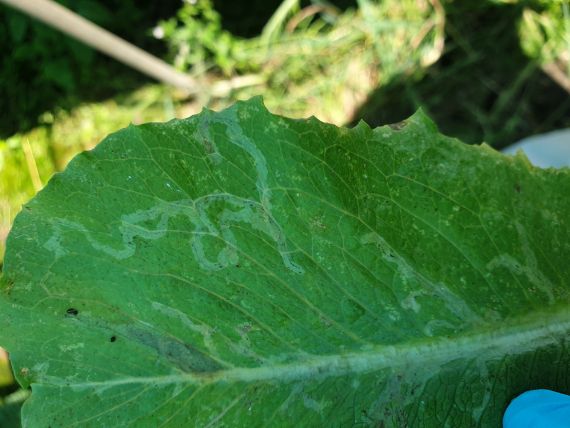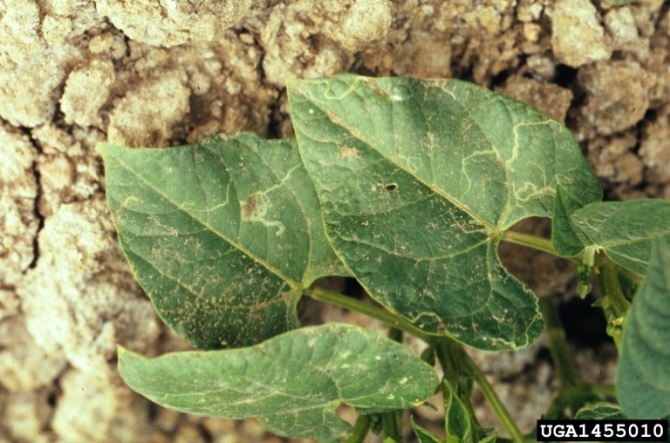
Serpentine leafminer
| Primefact number | Edition | Published | Author |
|---|---|---|---|
| PUB20/934 | First | Nov 2020 | Plant Biosecurity and Product Integrity |


![Figure 3 Liriomyza adult flies - L. huidobrensis adult (left) and L. trifolii (right) [<3 mm] (Image: Central Science Laboratory, Harpenden, British Crown, Bugwood.org) Composite image showing at right black fly with yellow spot on back, yellow marking on head, and long translucent wings with black veins. At left black fly with larger yellow spot on back and brighter yellow marking on head.](https://www.dpi.nsw.gov.au/__data/assets/image/0013/1140133/ExoticLeafMiner1.jpg)

Current situation
Updated: 7 March 2022
Serpentine leaf miner poses a serious threat to Australian agriculture and horticultural industries. Severe infestations of serpentine leaf miner may result in premature leaf drop, poor growth, and reduced crop yields.
In 2020 NSW DPI and Local Land Services responded to a confirmed report of serpentine leafminer (Liriomyza huidobrensis). NSW DPI and Local Land Services launched an emergency response that involved surveillance and tracing to delimit the extent of the infestation.
The Consultative Committee on Emergency Plant Pests is Australia’s key technical body for coordinating national responses to emergency plant pest incursions and assessing the technical feasibility for their eradication. The committee recommended that serpentine leafminer (SLM) was not technically feasible to eradicate due to the extent of the infestation.
Based on this recommendation, NSW DPI transitioned to management in early 2021. This focused on managing pathways of spread, abating domestic trade issues to retain market access, ensuring control options are available and that industry is supported through the changes in required pest management to ensure business continuity.
The pest is now considered established in NSW and QLD.
Chemical resistance
Worldwide, serpentine leafminer (SLM) and its related species have been reported resistant to many insecticides including group 1A & 1B organophosphates / carbamates, group 3A & 3B pyrethroids / DDT, group 17 cyromazine, group 6 avermectin and group 5 spinosyns. NSW DPI has used DNA based technology to test Australian invasive SLM quickly for resistance.
Resistance causing genes associated with organophosphate / carbamate (group 1A & 1B) and super pyrethroid (group 3A) resistance have been detected the NSW population. It is not yet known how widespread the resistance is, but clearly resistance causing genes has potentially significant consequences for effective field control of Australian SLM populations. To be cautious, we consider the use of such chemistries best avoided. If chemicals from groups 1 or 3 are to be used against SLM, always rotate to a different group for subsequent sprays and critically, never reapply the same chemical following a failure.
More information on chemical control options
General Biosecurity Duty
Part 3 of the Biosecurity Act 2015 describes how people have a General Biosecurity Duty to prevent, eliminate or minimise the risk of SLM in NSW. People dealing with SLM host plants which have visible signs of leaf miner damage must act to ensure they are meeting this General Biosecurity Duty. Put simply, you must always act to prevent further spread of SLM in NSW, eliminate heavy infestations of the pest and minimise the impacts of SLM in plant production systems. This duty may be met by any number of means that are considered Best Management Practice for SLM including by not selling heavily infested SLM host plants, through the use of integrated pest management to minimise the impact of SLM in the production system, adhering to industry standards such as Biosecure HACCP or market access arrangements like ICA-29, or treating host plants with approved insecticides, fumigation or irradiation to prevent spread in host produce.
Reporting
There is no obligation to report a suspect serpentine leafminer, however if you would like to submit samples for testing or send in a sticky trap for identificaiton you can use one of the following methods. [PLEASE NOTE: You are responsible for paying for the postage and processing costs of any samples that you submit for testing].
For situations where there is leafmining damage on multiple host species, submit a leaf sample following this method
- Collect small leaves or parts of large leaves that have obvious, recent leafminer tunnels in them
- If you find small brown pupae (1-2mm long) on the underside of leaves collect these as well
- Place the samples in a zip lock sandwich bag. Press the air out and securely zip the lock fully closed
- Write on the front of the bag in permanent black marker the name of the host plant, date and location address collected and the name of the person who collected it
- Collect each host plant in a different zip lock bag
- Place all of the sample bags inside one larger zip lock bag (to ensure all insects are contained) and place inside a padded envelope with a completed Plant Health Diagnostic Service Specimen Advice form
- Post to:
Attn: SLM
Plant Health Diagnostic Service
EMAI, Woodbridge Rd
Menangle NSW 2568
If you suspect a leafminer infestation you can submit a sticky trap for identification:
- Place a yellow sticky trap in the crop/garden so that the bottom of the trap is level with the top of the plants
- Leave it out for 5 days
- Take a plastic A4 sleeve and in black permanent marker write the trap collection date, property address and a contact name and phone number on the front
- With scissors cut open the sealed outer edges of the plastic sleeve so that it opens like a book
- Place the sticky trap carefully on one side of the plastic sleeve and close the plastic sleeve gently over the trap so you don’t squash any insects on the trap
- Place inside a padded envelope with a completed Insect Identification Request form
- Post to:
Attn: SLM
Biosecurity Collections
Orange Agricultural Institute
1447 Forest Rd, Orange NSW 2800
Webinar
This webinar was held in response to the detection of Serpentine leafminer in Western Sydney in late 2020, providing information on pest biology and chemistry, integrated pest management and regulatory requirements.
Description
Adults
The adult flies are small (<3 mm) and grey-black with yellow markings. Usually there is a prominent yellow area at the base of the wings.
Larvae
The larvae of Liriomyza species are yellow to white and usually concealed within the leaf in tunnels where they feed.
More visible than the larvae themselves are the patterns created in the surface of infested leaves by their tunnelling. The twisting trails appear whitish on the surface of the leaf and become longer and wider as the larva grows.
Damage
The larvae of all Liriomyza species ‘mine’ the leaves of host plants. The larvae feed by tunnelling through the leaf tissue.
Extensive tunnelling across leaf surfaces reduces the ability of the plant to photosynthesise and produce energy. Feeding and egg laying damage can also create small wounds across the leaf surface. Severe damage can result in leaf death or premature leaf drop.
If severe mining occurs early in the fruiting period, defoliation can reduce yield and fruit size and expose fruit to sunburn. Damaged leafy vegetables are unmarketable to supermarkets.
Lifecycle
Female flies use their ovipositor to puncture the leaves of host plants and deposit eggs. The eggs are inserted just below the leaf surface. Many eggs may be laid on a single leaf.
There are three larval stages that feed within the leaves. The larvae usually fall from the plant to the soil to pupate.
The entire life cycle can be completed in as little as two weeks. If conditions are favourable, the flies can reproduce all year round and sustain five to ten generations per year.
Spread
Spread of Liriomyza flies in Australia is most likely to occur with the transport of plant host material containing eggs or larvae.
The adults are capable of flight but are not very active fliers. They tend to fly within a crop but rarely between crops. Localised spread of the pest is most likely to occur through wind dispersal or on contaminated plant material or equipment.
Hosts
Serpentine leafminer is a significant pest of a number of vegetable crops including beans, cabbage, capsicum, celery, chilli, cucumber, eggplant, lettuce, onions, peas, potatoes and tomatoes. Ornamental plants including cut flowers are also hosts as are some weed species. See the full host list
Distribution
SLM was found in western Sydney in October 2020. Queensland reported a detection in the Fassifern Valley in November 2020.
Due to the extent of the infestation discovered through surveillance activities at the time it is now considered established in NSW and QLD.
Globally, SLM is found in Africa, Asia, Europe, North and South America.
Actions to minimise risk
Production nurseries and growers should check their crops regularly for signs of plant pests and disease.
Put in place biosecurity best practice actions to prevent entry, establishment and spread of pests and diseases:
- practise “Come clean, Go clean”
- ensure all staff and visitors are instructed in and adhere to your business management hygiene requirements
- monitor your crops regularly
- monitor and control volunteer plants that can harbour the pest
- source plant material of a known high health status from reputable suppliers
- keep records
Good on-farm biosecurity practices are vital to preventing incursions of plant pests and diseases. The farmbiosecurity.com.au website has helpful information that can be tailored to your property.
Resources
- Reporting and Testing for Serpentine Leafminer (PDF, 691.84 KB)
- Management of Serpentine Leafminer (PDF, 320 KB)
- Chemical management options for serpentine leafminer
- Host species list for serpentine leafminer
- The General Biosecurity Duty for Serpentine Leafminer (PDF, 184.8 KB)
- Primefact - Serpentine leafminer (PDF, 505.08 KB)
- Poster - Serpentine leafminer (PDF, 6841.49 KB)
- Flyer - Serpentine leafminer (PDF, 11452.79 KB)
Translated materials
- Poster - Simplified Chinese (PDF, 3509.75 KB)
- Flyer - Simplified Chinese (PDF, 3695.61 KB)
- Management of Serpentine Leafminer - Simplified Chinese (PDF, 426.49 KB)
- Reporting and Testing for Serpentine Leafminer - Simplified Chinese (PDF, 780.51 KB)
- The General Biosecurity Duty for Serpentine Leafminer - Simplified Chinese (PDF, 221.46 KB)
- Poster - Arabic (PDF, 3552.56 KB)
- Flyer - Arabic (PDF, 3743.77 KB)
- Management of Serpentine Leafminer - Arabic (PDF, 485.55 KB)
- Reporting and Testing for Serpentine Leafminer - Arabic (PDF, 780.66 KB)
- The General Biosecurity Duty for Serpentine Leafminer - Arabic (PDF, 271.67 KB)
- Poster - Khmer (PDF, 3533.5 KB)
- Flyer - Khmer (PDF, 3751.13 KB)
- Management of Serpentine Leafminer - Khmer (PDF, 433.66 KB)
- Reporting and Testing for Serpentine Leafminer - Khmer (PDF, 794.57 KB)
- The General Biosecurity Duty for Serpentine Leafminer - Khmer (PDF, 249.94 KB)
- Management of Serpentine Leafminer - Vietnamese (PDF, 1096.66 KB)
- Reporting and Testing for Serpentine Leafminer - Vietnamese (PDF, 1041.88 KB)
- The General Biosecurity Duty for Serpentine Leafminer - Vietnamese (PDF, 353.16 KB)

